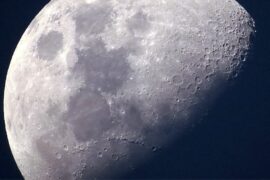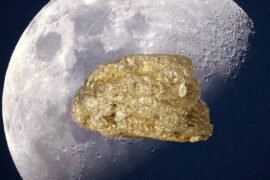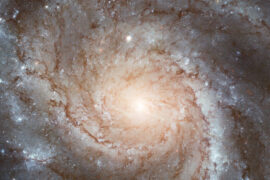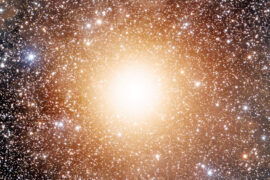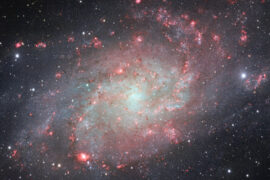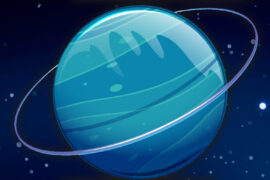Every night we can see the Moon in the sky over our planet. Since ancient times, people like you and me have wondered Why is it there? What is it made out of? How far is it?
By studying it, scientists and astronomers have managed to answer a lot of these questions.
In this article, we’ll take a look at some of the most interesting facts about the Moon for kids so they can learn more about this beautiful natural wonder.
What is The Moon?
A moon (also called a natural satellite) is basically a big rock that orbits or travels in circles around a planet just like a planet orbits the Sun. Moons are smaller than the planet they orbit and have a rocky surface. Some planets have many moons, but our planet only has one and we simply refer to it as the Moon.
The Moon completes one trip around Earth every 27 days approximately and is located 382,500 kilometers (237,600 miles) away from our planet. That is approximately 85 times the length of the United States.
Moon Facts for Kids
1. The Moon orbits Earth
The Moon travels in circles around our planet. We call that “orbiting”. Earth is also moving through space and it orbits the Sun. The three objects along with the rest of the Solar system are in a permanent dance that repeats again and again.
It takes the Moon around 27 days to make one full trip around Earth. As a result, of this movement, the Moon has phases and eclipses occur.
The Moon is not very fast. It travels at a speed of 1 kilometer per second (0.6 miles per second). That is slower than a person jogging.
2. The Moon is almost as old as Earth
All the planets in the Solar system formed about 4.6 billion years ago. And while the Moon is slightly younger than Earth, they are pretty close to having the same age.
Scientists think that the age of the Moon is somewhere between 4.4 and 4.5 billion years. This means that the Moon has been there for almost all of Earth’s history and it has been our companion for a veeeery long time.
3. The Moon formed when another planet hit Earth
How did the Moon get there?
There are a few theories about how it happened. The most likely one is that in the early days of the Solar system, there were other forming planets besides the eight that we know today. One of these planets (called Theia) which was about 1/3 the size of Earth hit our planet.
The impact sent out pieces of both planets flying around, and out of those chunks, the Moon formed.

4. The Moon is 400 times smaller than the Sun
From our point of view, the Moon seems to be about the same size as the Sun in the sky. This is why when there’s a solar eclipse, the Moon can block out the Sun.
However, this effect only happens because of perspective. The Moon is much closer to us than the Sun, so it appears to be larger. In reality, the Sun is almost 400 times bigger than the Moon in diameter.
5. We can only see one face of the Moon
Ancient civilizations didn’t know that the Moon rotated because it always seems to be facing us the same way. But this is not true.
The Moon rotates just like Earth. It just so happens to rotate at the exact same rate as its orbit. This means that we only get to see one side of it from Earth.
This phenomenon is called “tidal locking” and it is not uncommon among moons. For example, both of Mars’ moons are tidally locked as well as some of Jupiter’s largest moons.
The following animation should make this effect clearer.
6. Humans can’t breathe on the Moon
The Moon has air and an atmosphere, but it is too weak and has a very different composition than the air on Earth.
As a result, astronauts have to bring their own oxygen to be able to breathe on the Moon. This is packed into the spacesuits they use when they walk on the surface of the Moon.
7. The Moon is getting farther away from us
We can’t notice it because it is a very small change, but the Moon is constantly moving farther away from Earth. It moves about 1.5 centimeters (0.6 inches) every year.
This happens because of the interaction between the Moon and Earth’s oceans, which creates the tides.
But don’t worry, the Moon will not go too far away. In a few million years, it will reach a point of balance and it won’t go any farther.
8. The surface of the Moon is made of asteroid dust
The Moon is definitely not made out of cheese, as the saying goes. It is made of various types of rocks, and metals for the most part.
But one cool fact about the Moon is that its surface is made out of asteroid dust. This fine dust that is almost like sand is called regolith and it is the result of many asteroids impacting the surface of the Moon, leaving craters and breaking into this fine dust.
The layer of regolith in some areas of the moon is between 5m and 10 thick. This is why in the photos of astronauts walking on the Moon, they leave behind footprints as if they were standing on sand.
9. The Moon doesn’t shine
This might sound surprising because the Moon looks so bright at night, but the moon doesn’t shine and it doesn’t make light of its own.
The Moon looks bright to use because it reflects the light from the Sun. Because the sunlight hits the Moon at different angles depending on where they are both positioned, sometimes only certain parts of the Moon reflect it. This is when we see only a quarter or a half of the Moon. We refer to those different looks of the Moon as “phases”.
10. The Moon has water (but it’s mostly frozen)
Finding water in other places in the Solar system is exciting because it is very likely the key to the development of life as we know it.
This is why many of the missions to the Moon and Mars focus on finding traces of water.
In recent years, NASA has confirmed that there is water on the Moon. Most of it is beneath the surface and is frozen. The quantity of ice water on the Moon is very small, and it was probably left there by a comet or an asteroid, but finding it is an important step towards understanding more about it.
11. Twelve Astronauts have gone to the Moon
As you might already know, the first person to walk on the Moon was Neil Armstrong, on July 16, 1969.
After Neil, 11 other astronauts have walked on the Moon, all of them Americans, and all of them as part of the Apollo program. The last of these astronauts was Harrison Schmitt, on December 11, 1972.
NASA has announced its intentions to take another person to the Moon in the near future. This program is called Artemis and one of its goals is to have the first woman walk on the Moon.
12. The Moon has no life
As far as we know, Earth is the only place in the Solar system that supports life. There is no evidence that suggests that there could be life on the Moon.
However, that is no reason to stop studying the Moon. It still has a lot to teach us and it will be very important to the future of space exploration.


